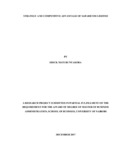| dc.description.abstract | The telecommunications industry in Kenya has faced challenges that have greatly affected the growth of competitiveness of this sector. These challenges are such as various strategy adoption like acquisition of new technology, culture change and environmental factors. The study aimed at establishing the strategies employed by Safaricom limited to achieve competitive advantage. The study is based on the following theories; resource based view theory and Porter's five forces theory. The case study was used in conducting this research. The use of case study method makes it possible to make a close examination of the data within a defined context. During the research, qualitative data was collected using interview guide administered to 4 senior managers of Safaricom limited or individuals in similar levels. The qualitative data collected was analyzed using content analysis technique. The study concluded that there are differences in organizational culture that influence the competitive advantage of Safaricom Limited. Managers at Safaricom Limited are acquiring an understanding of organizational culture contribution to the appreciation of performance of the organization. The study further concludes that leaders take into consideration the many elements involved in leading organizations through a smooth channel to eventually attain high performance. The study concludes that the product differentiation strategy from other players in the telecommunication industry enables Safaricom limited to remain competitive. Safaricom limited distinguish its' products in many ways either by using rare features, quick product innovation, having technological leadership, apparent prestige and status. On the technology adoption, the study found that Safaricom limited integrated system had all components of the organization integrated into one coherent system that enables the achievement of its mission. The study further concluded that, the threat of new entrants affects the competitive environment for Safaricom limited and existing competitors and influences the ability of existing firms to achieve profitability. Product innovation creates competitiveness at Safaricom limited. The adoption of new or significantly improved production methods improves competitiveness. The study further concludes that strategy formulation and allocation of resources are the major challenge facing Safaricom Limited in adopting strategies. It is the challenge of management to allocate them to their most useful tasks as well as coordinating and integrating activities of participating employees and functions. The study recommends that the government through communication authority of Kenya should ensure proper policies are in place to ensure telecommunication companies prices of products and services are standardized. The Safaricom managers should ensure an alignment in staffing to ensure a balanced work flow especially in the customer support departments where different levels of escalations have been put in place to address customer problems. The researcher faced difficulties in getting or accessing confidential business information from concerned employees due to fear of incrimination from management executives. A similar study should also be carried out in the major telecommunication firms in Kenya and a comparison with Safaricom in order to find out if these strategies have been a source of competitive advantage for them or not. | en_US |



